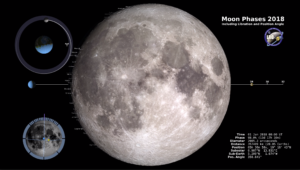I’d like to point readers’ attention to this wonderful visualization tool produced by the Scientific Visualization Studio at NASA Goddard Spaceflight Center and the Lunar Reconnaissance Orbiter Project. It’s a program that reproduces the Moon’s phase, position in its orbit, distance from the Earth, and libration state. You can bookmark the page and visit the site to enter a date and time for any time during 2018. Or you can download an MPEG movie and keep the information on your own computer.
Enjoy! And a Merry Christmas and Happy New Year to all!



Will you be participating in this event?
“Lunar Science for Landed Missions Workshop, January 10-12, 2018, at NASA Ames Research Center. This workshop is intended to produce a set of priority targets for near-term landed missions on the Moon, primarily, but not exclusively, from commercial exploration firms interested in pursuing ventures on the Moon. This workshop will result in a report to be presented to NASA Headquarters as an initial community consensus of priority landed targets, with the potential of future solicitations for science-focused payloads at such target sites.”
from https://lunar-landing.arc.nasa.gov/
Yes. I am also speaking that Friday at the annual TAMEST conference here in Houston about lunar return.
Interesting… I hope the Ina “D”-caldera is mentioned as a possible, low-latitude, Near Side source of volatiles!
And thanks for the link to the LRO Project! That quick map tool there (http://quickmap.lroc.asu.edu/) is exactly what I’ve been looking for. Speaking of Ina (18.6N, 5.3E), the resolution on that database is simply amazing–you can really see the mounds in all their weird glory. Google Moon would be a neat tool, but their resolution is really, very crappy….
Excellent! Thanks for the links.
I also like the classic Larry Niven short story ‘Inconstant Moon’:-)
Happy Holidays!
Marcel
Of course, Niven pinched it from Shakespeare:
O, swear not by the moon, th’ inconstant moon,
That monthly changes in her circle orb,
Lest that thy love prove likewise variable.
— Romeo and Juliet, Act 2, Scene 2
Also, an episode of (new) The Outer Limits. :^D
Spoiler: That episode from The Outer Limits was about the end of the world, and then it not quite being the end of the world.
Every few months I see in the news another rock has passed by Earth. Consider the consequences of a large impact. Large enough and life will be reduced to microbes. If smaller the particles in the atmosphere cause a nuclear winter and cannibal armies will roam the Earth and only a few million will eventually survive. The cannibal apocalypse was the premise of the movie “The Road.”
A super-volcano could also bring on that apocalypse.
But, let us say in a quarter century from now we have several human crewed atomic spaceships cruising deep space and a dinosaur killer is detected approaching Earth. No problem. It will take lunar resources to build those spaceships. The Moon is the only place to acquire cosmic ray water shielding, assemble, test, and launch Nuclear Pulse Propelled spaceships.
And let us say a century from now factories on the Moon are mass producing miles-in-diameter hollow spinning artificial moons and launching them into space. Hundreds of thousands of people a year ride beam-propelled single-stage-to-orbit vehicles to these cities in space. A super-volcano erupts and this multitude of space colonies actually sends the food necessary to save the population of Earth from starvation.
We better get started.
Merry Christmas to Dr. Spudis and family and to all our service members everywhere, to our citizens, and to everybody on this good Earth.